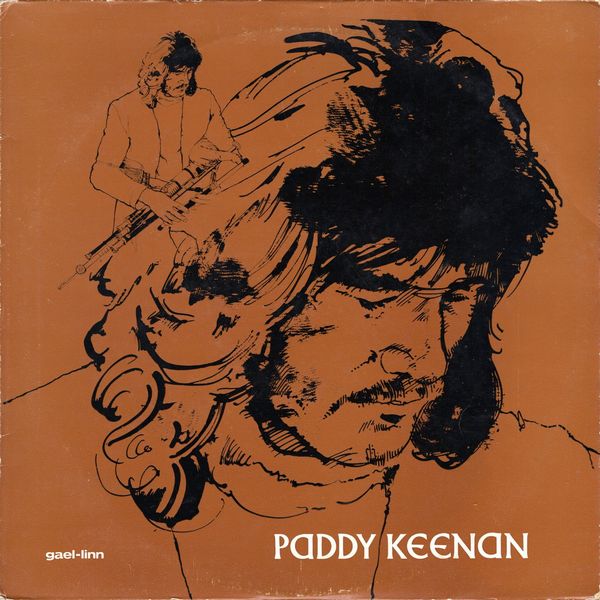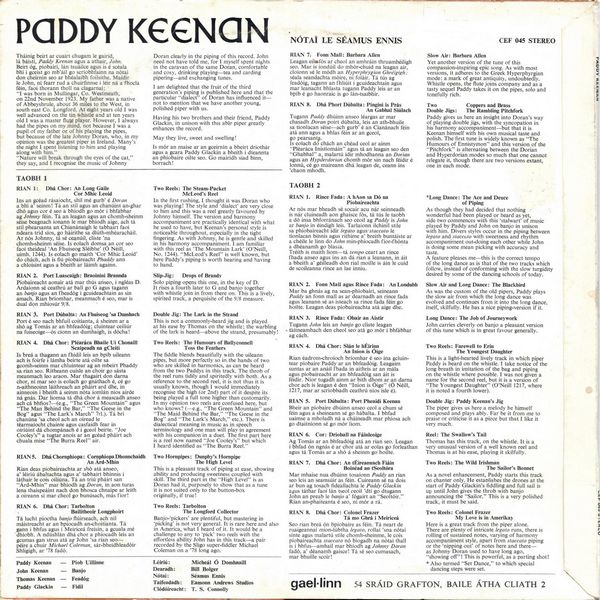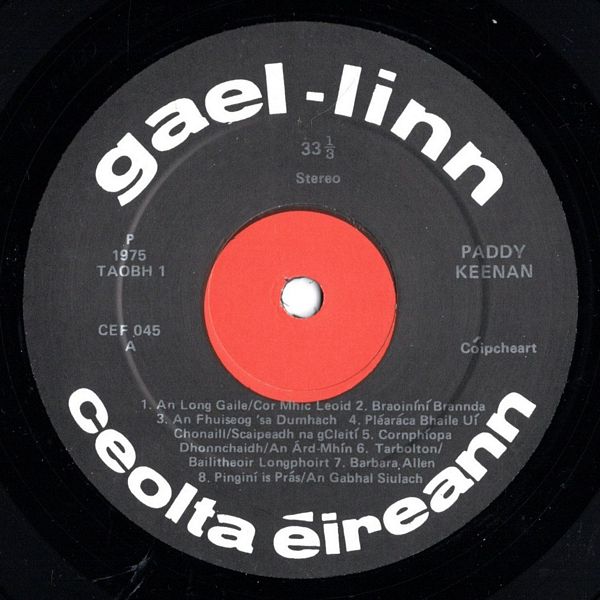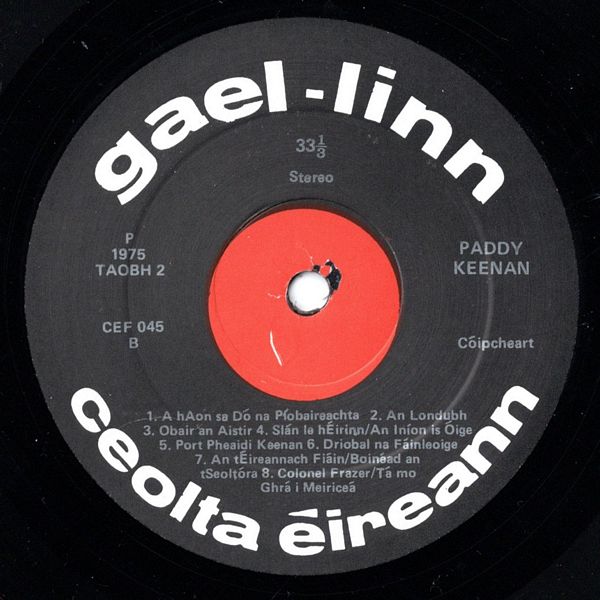
 |



|
Sleeve Notes
"I was born in Mullingar, Co. Westmeath, on 22nd November 1923. My father was a native of Abbeyshrule, about 36 miles to the West, in south east Co. Longford. At eight years old I was well advanced on the tin whistle and at ten years old I was a master flute player. However, I always had the pipes on my mind, not because I was a pupil of my father or of his playing the pipes, but because of the late Johnny Doran, who, in my opinion was the greatest piper in Ireland. Many's the night I spent listening to him and playing along with him."
John Keenan as told to Séamus Ennis
"Nature will break through the eyes of the cat," they say, and I recognise the music of Johnny Doran clearly in the piping of this record. John need not have told me, for I myself spent nights in the caravan of the same Doran, comfortable and cosy, drinking playing — tea and carding pipering — and exchanging tunes.
I am delighted that the fruit of the third generation's piping is published here and that the particular "dialect" of Doran has influenced it — not to mention that we have another young, polished piper with us.
Having his two brothers and their friend, Paddy Glackin, in unison with this able piper greatly enhances the record.
May they live, sweet and swelling!
Séamus Ennis
Dhá Chor: An Long Gaile & Cor Mhic Leoid [Two Reels: The Steam-Packet & McLeod's Reel] — In the first rushing, I thought it was Doran who was playing! The style and 'dialect' are very close to him and this was a reel greatly favoured by Johnny himself. The version and harmony accompaniment are practically identical with what he used to have, but Keenan's personal style is noticeable throughout, especially in the tight fingering. As with Johnny, he is gentle and skilled in his harmony accompaniment. I am familiar with this reel as 'The Mountain Lark' (O'Neill, No. 1244). "McLeod's Reel" is well known, but here Paddy's piping is worth hearing and having to hand.
Port Luascaigh: Braoiníní Brannda [Slip-Jig: Drops of Brandy] — Solo piping opens this one, in the key of D. It rises a fourth later to G and banjo together with whistle join in from there on. This is a lively, spirited track, a perquisite of the 9/8 measure.
Port Dúbalta: An Fhuiseog 'sa Dumhach [Double Jig: The Lark in the Strand] — This is not a commonly-heard jig and is played at his ease by Thomas on the whistle; the warbling of the lark is heard — above the strand, presumably!
Dhá Chor: Pléaráca Bhaile Uí Chonaill & Scaipeadh na gCleití [Two Reels: The Humours of Ballyconnell & Toss the Feathers] — The fiddle blends beautifully with the uileann pipes, but more perfectly so in the hands of two who are skilled in harmonics, as can be heard from the two Paddys in this track. The throb of the reel runs tidily and spiritedly with both. As a reference to the second reel, it is not thus it is usually known, though I would immediately recognise the high (or 2nd) part of it despite its being played a full tone higher than customarily.
In my opinion two reels are confused here, but who knows? (— e.g., "The Green Mountain" and "The Maid Behind the Bar," "The Geese in the Bog" and "The Lark's March," etc.). There is dialectical meaning in music as in speech terminology and one man will play in agreement with his companion in a duet. The first part here is a reel now named "Joe Cooley's" but which I heard identified as "The Burra Reel."
Dhá Chornphíopa: Cornphíopa Dhonnchaidh An árd-Mhín [Two Hornpipes: Dunphy's Hornpipe The High Level] — This is a pleasant track of piping at ease, showing ability and producing sweetness coupled with skill. The third part in the "High Level" is as Doran had it, purposely to show that as a tune it is not suited only to the button-box originally, if true!
Dhá Chor: Tarbolton & Bailitheoir Longphoirt [Two Reels: Tarbolton & The Longford Collector] — Banjo-'pickers' are plentiful, but mastering in 'picking' is not very general. It is rare here and also in America, what I heard of it. It would be a challenge to any to 'pick' two reels with the effortless ability John has in this track — a pair recorded by the Sligo super-fiddler Michael Coleman on a '78 long ago.
Fonn Mall: Barbara Allen [Slow Air: Barbara Allen] — Yet another version of the tune of this compassion-inspiring epic song. As with most versions, it adheres to the Greek Hyperphyrgian mode: a mark of great antiquity, undoubtedly. Whistle opens, the flute joins company and as a tasty sequel Paddy takes it on the pipes, solo and tonefully rich.
Dhá Phort Dúbalta: Pinginí is Prás & An Gabhal Siúlach [Two Double Jigs: Coppers and Brass & The Rambling Pitchfork] — Paddy gives us here an insight into Doran's way of playing double jigs, with the syncopation in his harmony accompaniment — but that it is Keenan himself with his own musical taste and polish. The first tune is widely known as "The Humours of Ennistymon" and this version of the "Pitchfork" is alternating between the Dorian and Hyperdorian modes so much that one cannot relegate it, though there are two versions extant, one in each mode.
Rince Fada: A hAon sa Dó na Píobaireachta [Long Dance: The Ace and Deuce of Piping] — As though they had decided that nothing wonderful had been played or heard as yet, side two commences with this 'stalwart' of music played by Paddy and John on banjo in unison with him. Divers styles occur in the piping between legato and staccato with sweetness and rhythm accompaniment out-doing each other while John is doing some mean picking with accuracy and taste. A feature pleases me — this is the correct tempo of the long dance as is that of the two tracks which follow, instead of conforming with the slow turgidity desired by some of the dancing schools of today.
Fonn Mall agus Rince Fada: An Londubh [Slow Air and Long Dance: The Blackbird] — As was the custom of the old pipers, Paddy plays the slow air from which the long dance was evolved and continues from it into the long dance, itself, skilfully. He has a nice piping-version if it.
Rince Fada: Obair an Aistir [Long Dance*: The Job of Journey work] — John carries cleverly on banjo a pleasant version of this tune which is in great favour generally.
Dhá Chor: Slán le hÉirinn & An Inion is Óige [Two Reels: Farewell to Erin & The Youngest Daughter] — This is a light-hearted lively track in which piper Paddy is heard on the whistle. I take notice of the long breath in imitation of the bag and piping on the whistle where possible. I was not given a name for the second reel, but it is a version of "The Youngest Daughter" (O'Neill 1217, where it is noted a fourth lower).
Port Dubalta: Port Pheaidí Keenan [Double Jig: Paddy Keenan's Jig] — The piper gives us here a melody he himself composed and plays ably. Far be it from me to praise or criticise it as a piece but that I like it very much.
Cor: Drioball na Fáinleoige [Reel: The Swallow's Tail] — Thomas has this track, on the whistle. It is a very unusual version of a well known reel and Thomas is at his ease, playing it skilfully.
Dhá Chor: An tÉireannach Fiáin & Boinéad an tSeoltóra [Two Reels: The Wild Irishman & The Sailor's Bonnet] — As a novel enhancement, Paddy starts this track on chanter only. He establishes the drones at the start of Paddy Glackin's fiddling and full sail is up until John gives the throb with banjo announcing the "Sailor." This is a very polished track, it must be said.
Dhá Chor: Colonel Frazer & Tá mo Ghrá i Meiriceá [Two Reels: Colonel Frazer & My Love is in Amerikay] — Here is a great track from the piper alone. There are plenty of intricate legato runs, there is rolling of sustained notes, varying of harmony accompaniment style, apart from staccato piping or the 'nipping out' of notes here and there — as Johnny Doran used to have long ago, "showing off"! This is powerful, as a parting shot!
* Also termed "Set Dance," to which special dancing steps were set.